North Country Honor Flight #66 travels to Washington D.C.
North Country Honor Flights #66 and #67 took to the skies on Saturday, October 4, 2025. Dave Brown took photos of the Send-Off Ceremony and allowed the Peru Gazette to post them. Thank you! Dave. Gina Bond provided the veteran biographies. These veterans flew on Flight #66.
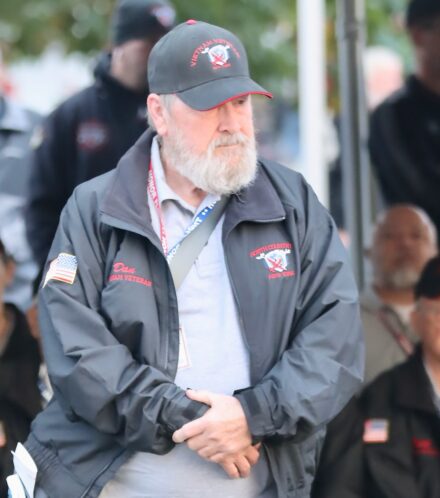 Daniel Ballantine, US Air Force, 1968-1989, Vietnam
Daniel Ballantine, US Air Force, 1968-1989, Vietnam
Daniel’s specialty training would take him to Keesler AFB to become a radio operator. Limited facilities utilizing his specialty would initially restrict his placement. A one-year combat crew communications assignment in Belgium would precede a placement at MacDill in Florida as a radio operator.
In Hawaii, Daniel would utilize the Mystic Star communications system, which provided secure communication links for high-ranking officials, including the President and Vice-President, while aboard Special Air mission aircraft.
Throughout his twenty-one-year enlistment, he would spend time at bases in Austin, Texas, Guam, Myrtle Beach, and Plattsburgh, some of which would be multiple assignment locations. While in Guam, he would venture into the mile-wide eye of Typhoon Tip as it passed through.
The service allowed him to earn two associate degrees. He would nearly complete a bachelor’s degree in engineering, but scheduling required coursework complicated this goal. Daniel received many commendations and awards for his service. He is proud of his many military accomplishments and grateful for the opportunities offered him.
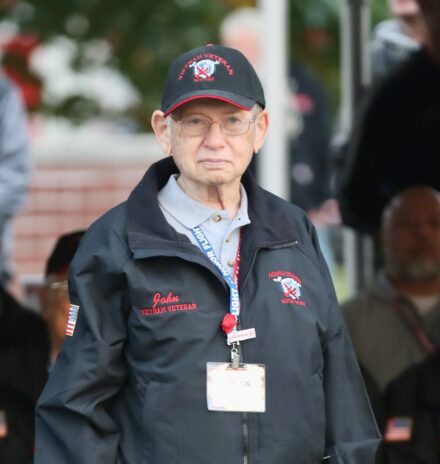 John Cohen, US Navy 1962-1964, Vietnam
John Cohen, US Navy 1962-1964, Vietnam
John, one class short of his college degree, would join the Navy at age 22. An incident with the boot camp DI and a recruit lawyer would set a hands-off approach to their training.
A shore duty assignment at Patuxent, Maryland, would place John in personnel. Not needed in this position, his typing skills would have him preparing orders. John’s attention to detail, and errors by others, would ensure all future orders “first go through Cohen.” Newly married, John’s wife would want to join him. This request would get him sent to sea duty at Kittery, Maine, where he’d be assigned to the USS Thor. Standing watch, he’d receive a 45 pistol, but he’d never received any weapons training. The gunner’s mate would instruct him.
The USS Thresher incident nearby would bring the Admiral to their area. Assigned to drive him, John would go through a stop sign. Although no injuries resulted, the Admiral would not be impressed. Given a work crew, John would be in charge of disposal of furniture, he decided the most efficient removal method would be to send it out the window. His commanding officer would disagree. Prior to discharge, John would get the promotion and rank for the job he was performing.
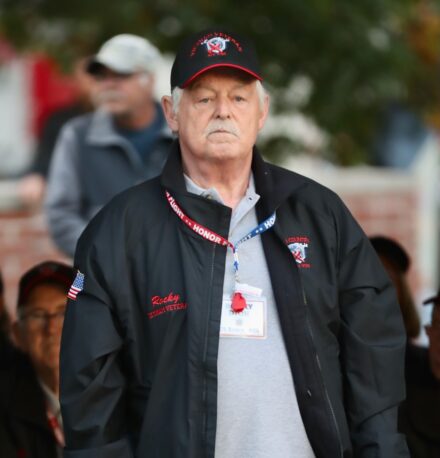 Rocky Dion, US Army, 1972-1974, Vietnam
Rocky Dion, US Army, 1972-1974, Vietnam
Rocky would enter the military through the draft. He would receive extensive training as an artillery surveyor, learning to perform astronomical observations, measure azimuths, angles, and determine deviations for target, connection, and position. Twice, packed and ready, Rocky’s orders for Vietnam would get pulled. Instead, he would be sent to Germany, where he would stay for 18 months. While there, he would get an apartment with his buddies. One of them would have a car, allowing them travel options.
Often assigned to drive, transporting the Lieutenant allowed him to arrive at a location for a bath, a luxury he appreciated and needed after a lengthy stay in the field. While driving a 5 1/4 truck 30 kilometers, the front tire fell off. With a firm grip on the wheel, he safely stopped the truck without injuries. Rocky considered reenlistment at the end of his service commitment but was ready to return home to civilian life. He appreciated the discipline the service instilled in him and believes everyone would benefit from time spend in service.
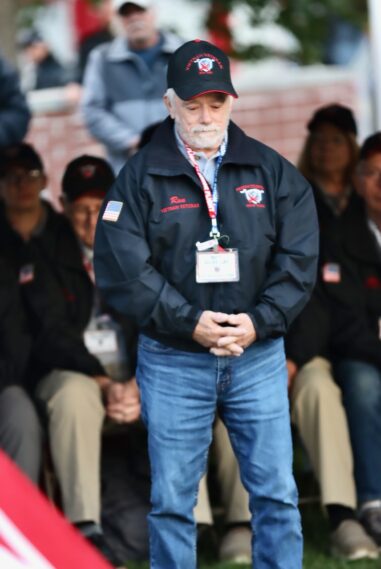 Ronald Douglas, US Marine Corps, 1971-1973, Vietnam
Ronald Douglas, US Marine Corps, 1971-1973, Vietnam
Ron decided to join the Marine Corps, as not to be drafted. Their enlistment time was two years; the only downside was that he wouldn’t have any input into his assignment. Arriving at Parris Island, he found himself sleeping on the floor due to insufficient beds. He awoke early that next morning to the sound of a metal garbage can thrown by the DI.
After basic Ron would be send to Camp Lejeune. Surprised, Ron was assigned the position of cook and would remain there for his entire military commitment. He enjoyed his work and made friends while there.
Ron, unsettled as a youth, appreciates the structure and discipline he received in the service. He would marry within a year of entering the service, and often thinks what might have been had he chosen to reenlist. Today, he’s proudly accompanied by his son, Ron Jr., also a Marine Corps veteran.
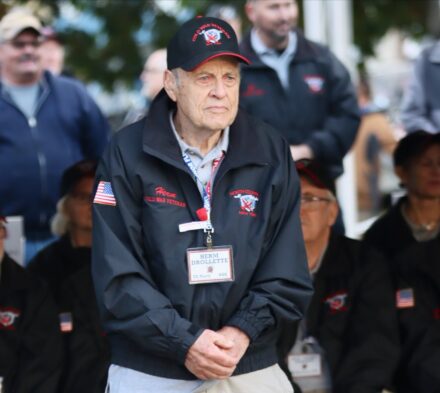 Herman Drollette, US Navy, 1955-1957, Cold War
Herman Drollette, US Navy, 1955-1957, Cold War
Herman would join the Navy out of high school with a couple of his friends. He would spending a good amount of time marching, which wouldn’t be much help to him aboard ship serving as a boiler tender. During training on the USS Reversal firemen would be sent down the hatch to extinguish fire wearing insufficient fire gear.
Spending his entire assignment on the USS Moale, Herman would work with a team of six at one of the ship’s four boilers. A dangerous job: the superheated steam could easily take off fingers. Sailors did not wear dog tags as the metal would burn their skin. Ship noise from cannon firings and asbestos would cause later health issues for many aboard. At port, the ship’s crew would form a chain to load ammunition, food, and other supplies. The ship would take him to many ports; he would see France, Libya, Greece, and Hungary. At one port a shipmate would steal a flag, causing the ship to stay at port longer than planned.
Herman exited the military with pride of service, lifetime friends, and a career working on boilers, serving as mechanical superintendent on base for 35 years.
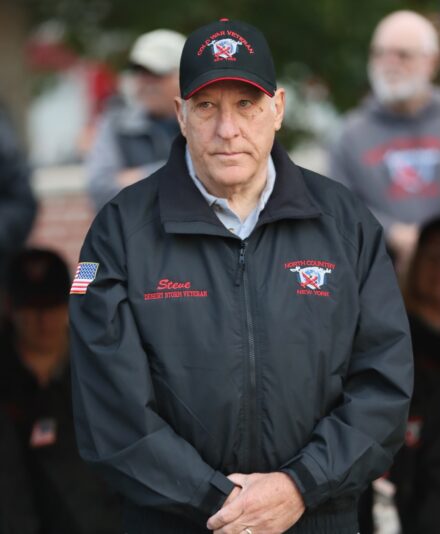 Steven Fulton, US Air Force, 1980-2001, Cold War, Desert Storm
Steven Fulton, US Air Force, 1980-2001, Cold War, Desert Storm
From OTS, Steve reported to KC-135 Crew Training, including survival and POW training. His first assignment, navigator in the 310th Air Refueling Squadron. On the FB-111A, he would serve in many capacities, from navigator to chief flight instructor. As Action Officer and KC-135 Plans Officer, he drafted, updated, and maintained SAC nuclear wartime regulations and procedures. Assigned to 9th Combat Crew, Steve would fly as an offensive systems operator, also developing and conducting training missions. He would go on to serve as ROTC commander and instructor, and B-1 flight operations trainer. TDY assignments with the Tanker Task Force would take him worldwide. A deployment to Brisbane, Australia, put him in command of a two-week mission of two B-1 aircraft, four flight crews, and 140 maintenance personnel. A notable career highlight was circumnavigating the Earth with two B-1 aircraft, setting three world records, and winning the McKay Trophy.
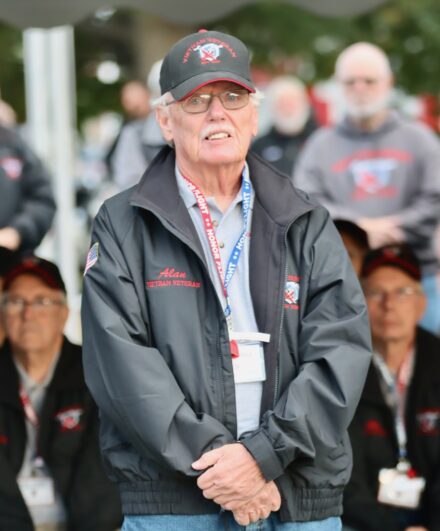 Harold “Alan” Greene, US Navy 1966-1970, Vietnam
Harold “Alan” Greene, US Navy 1966-1970, Vietnam
Alan had expected the Navy to fulfill his enlistment guarantee of medical specialized optical training, but after corpsman training at Camp Lejeune, he found himself on a plane to Vietnam. Despite feeling he’d return home, Alan’s landing amongst burning planes and a running safety exit didn’t make for a good start. During his year-long deployment, he gave medical care in the field and at Charlie Med “MASH” unit at Khe Sanh.
Assigned to the 2nd Battalion, 1st Marines, Alan worked alongside doctors often 15-20 feet underground to keep artillery out. His daily routine involved blood, injury, and death. Alan would be saved by his helmet on two occasions, twice shot in the head. He would receive a Purple Heart for injuries sustained while administering medical services in the field. He would be unaware of being shot in the front and back. Despite the blood, his adrenaline would keep him moving. Later, he managed to sew up his own wounds. Leaving the field in a 14-vehicle convoy from Du Nang to Phi Bai to Hue, Alan was on one of the only two vehicles making it out; all others would be lost. Traveling home at Albany, NY, he would have only 22 cents in his pocket.
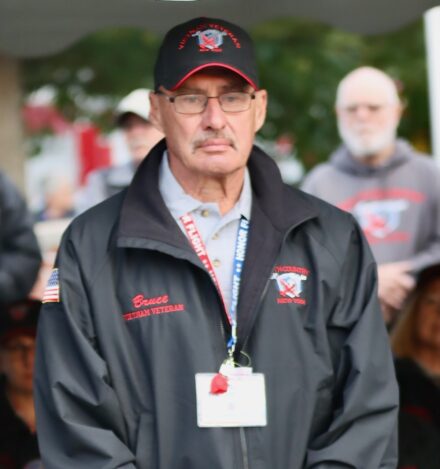 Bruce McCormick, US Navy, 1969-1971, Vietnam
Bruce McCormick, US Navy, 1969-1971, Vietnam
Joining the Navy at Great Lakes, Bruce was selected as platoon leader, a decision he couldn’t explain. In advanced training, he trained as a gunner’s mate, learning all ship weapons nomenclature. Surprised, Bruce found himself at Roosevelt Roads Naval Station in Puerto Rico, doing shore duty instead of ship duty or Vietnam. On the range, he qualified base personnel for 45, M16, M14, M60, 50-caliber, 5” 38 weapons, and disassembling and weapons cleaning. Flight crews and pilots would use base ammunitions or arrive with bombs of all sizes for training exercises.
Bruce earned his military tractor-trailer license and ran deuce trucks. Electronic forklifts posed hazards due to debris on the floor while moving ammunition. As squad leader, he red carded out-of-date ammunition, loading them by pallet on to a barge that would be pulled by tugboat out to the deep waters for dumping. Bruce’s military experience taught him leadership by example, discipline, and order-following, which benefited his later civilian career.
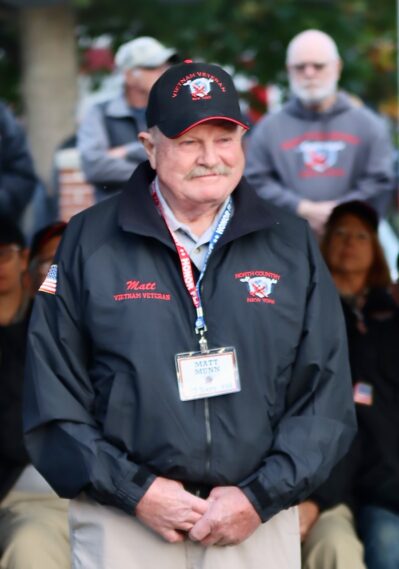 Matthew Munn, US Navy, 1968-1972, Vietnam
Matthew Munn, US Navy, 1968-1972, Vietnam
Matt joined the Navy as not be drafted. His military father would advise him before he left to “Do as you are told, and don’t volunteer.” After receiving Corpsman training Matt would spend 19 months at the Naval Air Station in Jacksonville before receiving orders for the destroyer USS Gurke. Here he would spend the next 13 months in the West Pacific area, including Japan, coastal Vietnam, the Philippines, Hong Kong, and Thailand. Two ship corpsmen would be assigned to the care of 250 soldiers aboard ship. With no doctor assigned, the Merck medical manual would be used as their medical source guide. With one year left, Matt would be moved to an LST troop cargo ship with 200 soldiers.
Belonging to a big family with 11 children, many of his siblings would also serve. Matt appreciated the experience and education he received, that allowed him to follow a path of service in his life. His only regret is that he did not follow through on a recommendation from the Squadron Doctor to pursue becoming a PA at the US Public Health Station for orthopedic surgery.
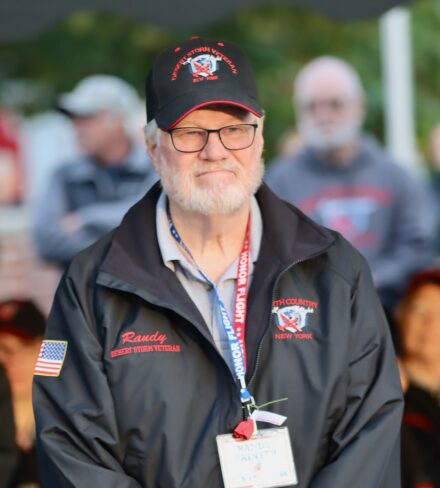 Randy Painter, US Air Force, 1976-1993, Cold War, Desert Storm
Randy Painter, US Air Force, 1976-1993, Cold War, Desert Storm
One year out of high school and no real career opportunities, Randy would join the Air Force. At Shepard, he would receive advanced training as a medic. Scoring high in this field, he would get his East Coast choice and was shipped to Plattsburgh. Here, Randy would be at the base hospital for 11 years, starting out in the ward and later being placed in charge of the ER. While there, he would save a young man’s life that had been badly stabbed by his roommate. Relocating to the Air Force Academy for 4 years, he would make rank, placing him in charge of the cadet clinic. TDY during Desert Storm would send him to England for 8 weeks as head of a 150-bed ICU. While there, they would only treat four patients.
Receiving a humanitarian assignment, he returned to Plattsburgh to help his mom as she had received a cancer diagnosis. Upon leaving the military, Randy would challenge the LPN exam based on his military medical service and obtained employment at CVPH. He is thankful for the lifetime career that the service provided to him, as well as the many good people he met throughout his military enlistment.
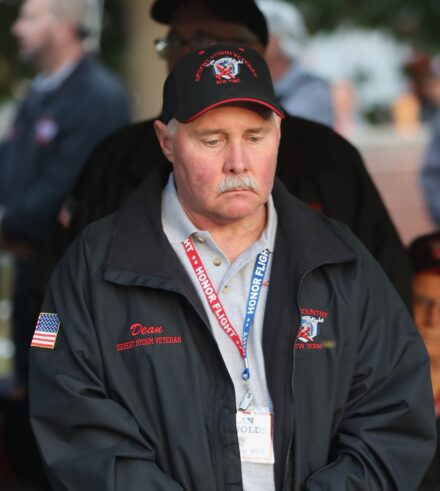 Dean Reynolds, US Army, 1982-1984, 1991 Cold War, Desert Storm
Dean Reynolds, US Army, 1982-1984, 1991 Cold War, Desert Storm
At 19, Dean completed basic training at Fort Jackson and advanced training on the Cobra helicopter at Fort Eustis. Next, he was assigned to Fort Polk in Louisiana for nearly 18 months, while there he married his high school sweetheart, Jada. Although it would be a very simple ceremony and celebration, they were happy to be back together. Dean would receive orders to Korea. Here he would be located about 10 miles from the DMZ, for a one-year deployment. Jada would not be allowed to join him at this location.Returning home, he served as a master fitness trainer in the active reserves. Here he would help soldiers qualify, meet reenlistment goals, and stay mission ready. This was a natural fit for him, as a marathoner who logged over 100,000 lifetime miles. Dean would be reactivated for 6 months during Desert Shield/Desert Storm, later finding his deployment orders canceled. Despite readiness to serve, heading off would be more worrisome with young sons at home. He is most proud of the personal recognition award he received during his service, as they only awarded two for each platoon of 80 soldiers.
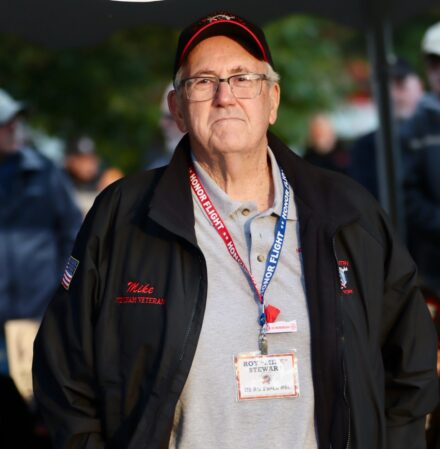 Roy “Mike” Stewart, US Air Force, 1966-1970, Vietnam
Roy “Mike” Stewart, US Air Force, 1966-1970, Vietnam
Roy’s mother took him to the recruiter a month after high school graduation, determined he wouldn’t join the Army. After basic training at Lackland, he started a 13-week training program in heavy equipment mechanics and operations at Fort Belvoir, Virginia. His first assignment would take him to Alaska for a year. He recalls the area’s beauty, but even in summer, the wind and cold kept him from removing his coat. For the rest of his active enlistment, he served in the 380th Transportation Squadron at Plattsburgh AFB. He attempted a switch to Texas with a friend, but the Air Force refused the trade in location. He would work as a mechanic and in heavy equipment. Roy married 6 months before completing his 4-years of service. He was happy to have served his country and has made his home in the North Country.
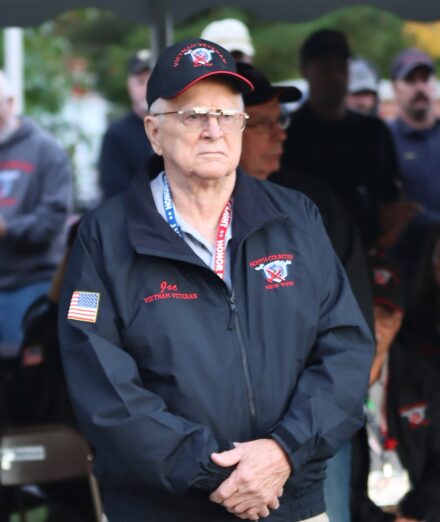 Joseph Theroux, US Air Force, 1957-1980, Vietnam
Joseph Theroux, US Air Force, 1957-1980, Vietnam
Upon graduation, Joseph would enlist, looking to pursue his passion for mechanics. His first training would be on B-47s. Within 6 months of his base assignment, he would be named crew chief. This would begin a 27-year career that would offer him many opportunities serving as Flight Chief, Line Chief, Organizational Maintenance Superintendent, and Alert Travel Maintenance Superintendent. He would be charged with having as many as 400 people working for him during his career. His aircraft responsibilities included B-47s, B-52s, KC-135s, and the FB-111s. It also involved loading nuclear weapons and working on bomber aircraft. Joseph’s service would send him abroad many times during his enlistment, traveling to Okinawa, Guam, England, and Thailand. Joseph credits his military service with making it possible to take care of his family, providing a stable career.
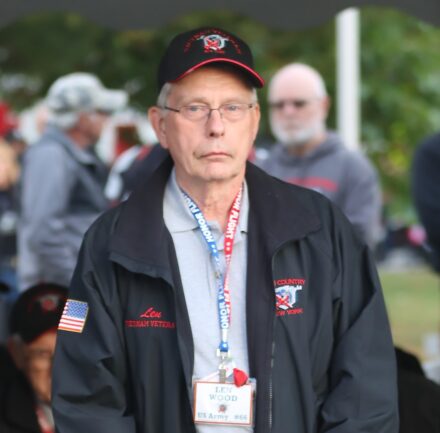 Leonard Wood, US Army Reserves, 1966-1971, Vietnam
Leonard Wood, US Army Reserves, 1966-1971, Vietnam
Facing the draft at 19, Leonard joined the Army Reserves. He completed basic and advanced training at Fort Dix, near his grandparents’ home. Here he would receive arms and infantry training, and a clerk assignment. With the 962 Ordinance Company, he served under his father’s strict supervision, handling all types of paperwork.Married, Leonard would return home. He would go on to complete a 6-year reserve commitment in the supply company, handling reservist equipment needs.
Proud to serve his country, carrying on three generations of family military tradition, including a son and daughter, Leonard’s experience made him more outgoing. Today, his daughter, Laurie, a retired Navy veteran, joins him in Washington, DC. She served a one-year deployment to Afghanistan and later became severely injured as a trainer at the Norfolk sheriff’s police academy.
Posted: October 13th, 2025 under Adirondack Region News, Community Events, General News, Honor Flights, National News, Northern NY News, Peru/Regional History, Upstate New York, Veterans' News.
